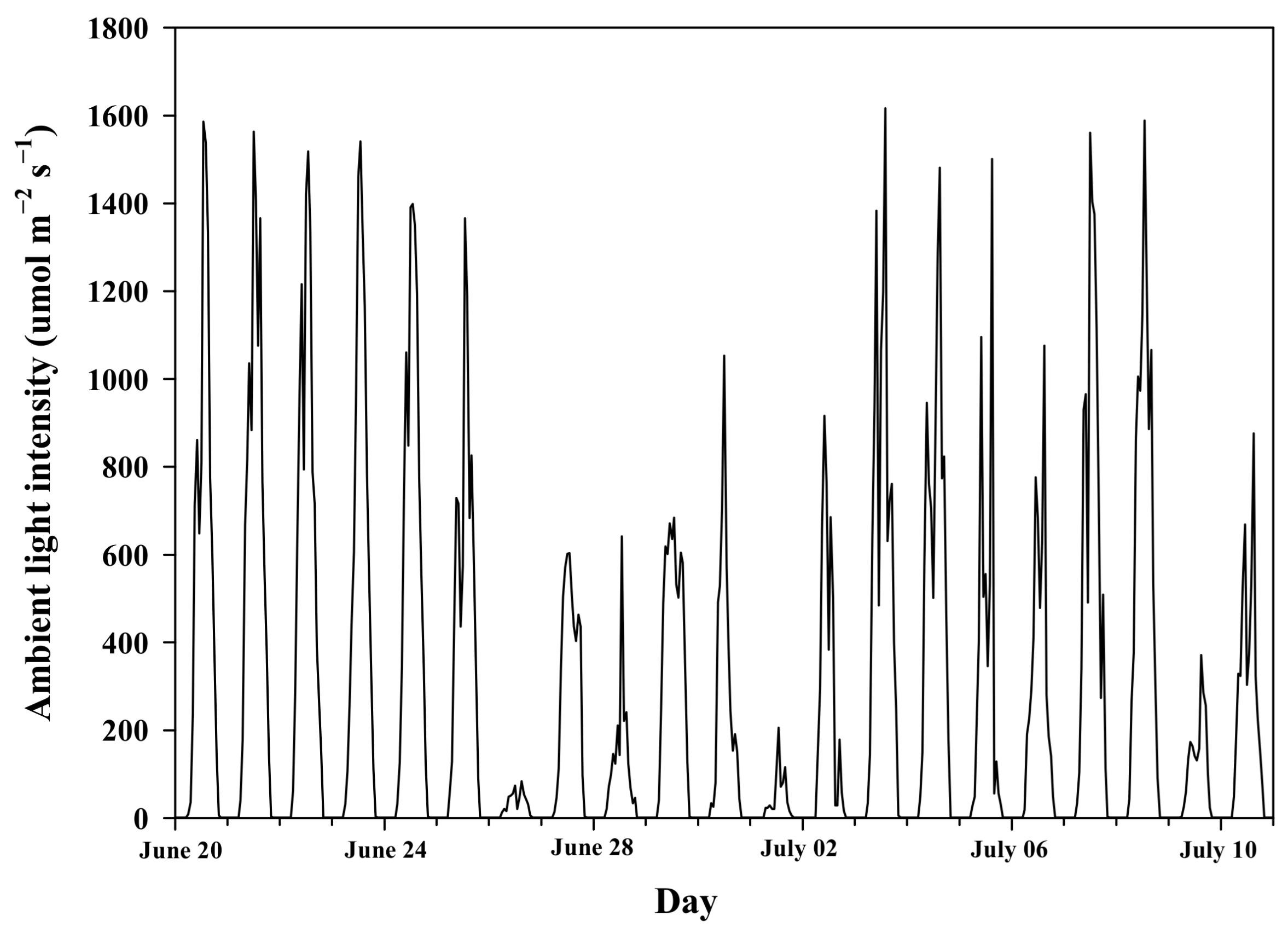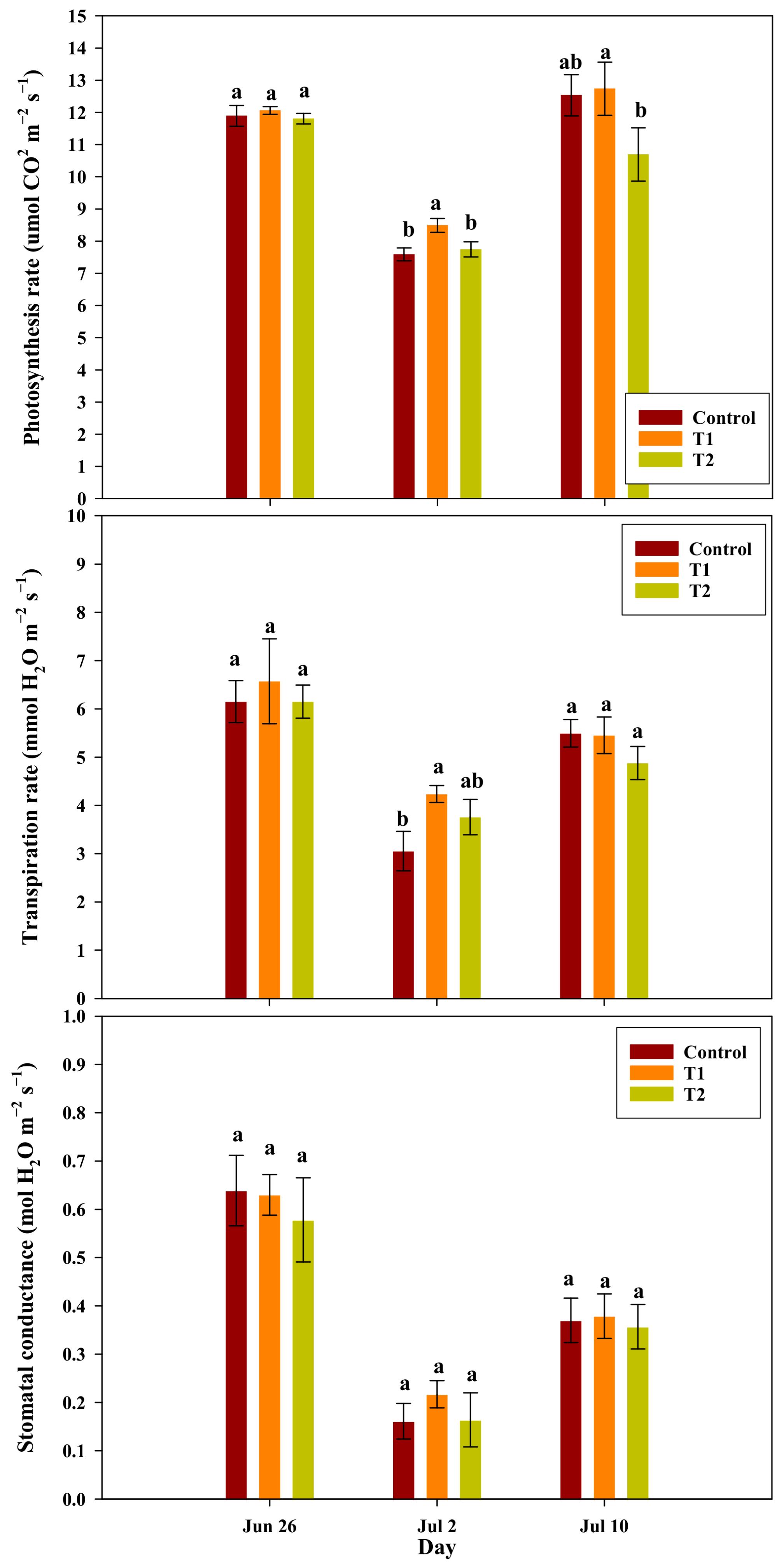Effect of TiO2 Nanoparticles on the Yield and Photophysiological Responses of Cherry Tomatoes during the Rainy Season
Abstract
:1. Introduction
2. Materials and Methods
2.1. Cherry Tomato Plant Cultivation
2.2. TiO2 Treatment
2.3. Chlorophyll a Fluorescence OJIP and Photosynthesis
2.4. Yield and Fruit Characteristics
2.5. Experimental Design and Statistical Analysis
3. Results
3.1. Ambient Light Intensity in the Greenhouse and TiO2 Absorbance
3.2. OJIP and Photosynthesis of Cherry Tomato
3.3. Yield and Fruit Characteristics of Cherry Tomato
4. Discussion
5. Conclusions
Funding
Institutional Review Board Statement
Informed Consent Statement
Acknowledgments
Conflicts of Interest
References
- Jeong, J.W.; Kim, S.; Lee, I.K.; So, N.; Ko, H.S. Negative effect of abnormal climate on the fruits productivity—Focusing on the special weather report. Korean J. Agric. For. Meteorol. 2018, 20, 305–312. [Google Scholar]
- Boyle, C.F.; Haas, J.; Kern, J.D. Development of an irradiance-based weather derivative to hedge cloud risk for solar energy systems. Renew. Energy 2021, 164, 1230–1243. [Google Scholar] [CrossRef]
- Lu, T.; Yu, H.; Li, Q.; Chai, L.; Jiang, W. Improving plant growth and alleviating photosynthetic inhibition and oxidative stress from low light stress with exogenous GR24 in tomato (Solanum lycopericum L.) seedlings. Front. Plant Sci. 2019, 10, 490. [Google Scholar] [CrossRef] [PubMed]
- Son, I.-C.; Moon, K.H.; Song, E.Y.; Wi, S.H.; Seo, H.-H.; Moon, Y.E.; Reddy, V.; Yang, J.; Sicher, R.; Oh, H. Growth and physiological responses of chinese cabbage to different light intensity until leafy head formation. Hortic. Sci. Technol. 2017, 36, 151–160. [Google Scholar] [CrossRef]
- Wei, H.; Park, J.E.; Park, Y.G.; Jeong, B.R. A survey on the graft healing environment of commercial fruit vegetable plug seedling greenhouses in the Republic of Korea. Hortic. Environ. Biotechnol. 2019, 60, 329–336. [Google Scholar] [CrossRef]
- Gruda, N.; Bisbis, M.; Tanny, J. Influence of climate change on protected cultivation: Impacts and sustainable adaptation strategies—A review. J. Clean. Prod. 2019, 225, 481–495. [Google Scholar] [CrossRef]
- Rodríguez-González, V.; Terashima, C.; Fujishima, A. Applications of photocatalytic titanium dioxide-based nanomaterials in sustainable agriculture. J. Photochem. Photobiol. C 2019, 40, 49–67. [Google Scholar] [CrossRef]
- Bakshi, M.; Liné, C.; Bedolla, D.E.; Stein, R.J.; Kaegi, R.; Sarret, G.; Pradas del Peal, A.E.; Castillo-Michel, H.; Abhilash, P.C.; Larue, C. Assessing the impacts of sewage sludge amendment containing nano-TiO2 on tomato plants: A life cycle study. J. Hazar. Mater. 2019, 369, 191–198. [Google Scholar] [CrossRef]
- Zahra, Z.; Waseem, N.; Zahra, R.; Lee, H.; Badshah, M.A.; Mehmood, A.; Choi, H.K.; Arshad, M. Growth and metabolic responses of rice (Oryza sativa L.) cultivated in phosphorus-deficient soil amended with TiO2 nanoparicles. J. Agric. Food Chem. 2017, 65, 5598–5606. [Google Scholar] [CrossRef]
- Sheikhalipour, M.; Esmaielpour, B.; Gohari, G.; Haghighi, M.; Jafari, H.; Farhadi, H.; Kulak, M.; Kalisz, A. Salt stress mitigation via the foliar application of chitosan-functionalized selenium and anatase titanium dioxide nanoparticles in Stevia (Stevia rebaudiana Bertoni). Molecules 2021, 26, 4090. [Google Scholar] [CrossRef]
- Jahan, S.; Alias, Y.B.; Bakar, A.F.B.A.; Yusoff, I.B. Toxicity evaluation of ZnO and TiO2 nanomaterials in hydroponic red bean (Vigna angularis) plant: Physiology, biochemistry and kinetic transport. J. Environ. Sci. 2018, 72, 140–152. [Google Scholar] [CrossRef]
- Gil Choi, H.; Moon, B.Y.; Bekhzod, K.; Park, K.S.; Kwon, J.K.; Lee, J.H.; Cho, M.W.; Kang, N.J. Effects of foliar fertilization containing titanium dioxide on growth, yield and quality of strawberries during cultivation. Hortic. Environ. Biotechnol. 2015, 56, 575–581. [Google Scholar] [CrossRef]
- Teszlák, P.; Kocsis, M.; Scarpellini, A.; Jakab, G.; Kőrösi, L. Foliar exposure of grapevine (Vitis vinifera L.) to TiO2 nanoparticles under field conditions: Photosynthetic response and flavonol profile. Photosynthetica 2018, 56, 1378–1386. [Google Scholar] [CrossRef]
- Won, J.S.; Lee, S.J.; Park, H.H.; Bin Song, K.; Min, S.C. Edible coating using a chitosan-based colloid incorporating grapefruit seed extract for cherry tomato safety and preservation. J. Food Sci. 2018, 83, 138–146. [Google Scholar] [CrossRef]
- Ahammed, G.J.; Xu, W.; Liu, A.; Chen, S. COMT1 silencing aggravates heat stress-induced reduction in photosynthesis by decreasing chlorophyll content, photosystem II activity, and electron transport efficiency in tomato. Front. Plant Sci. 2018, 9, 998. [Google Scholar] [CrossRef]
- Yang, X.; Xu, H.; Shao, L.; Li, T.; Wang, Y.; Wang, R. Response of photosynthetic capacity of tomato leaves to different LED light wavelength. Environ. Exp. Bot. 2018, 150, 161–171. [Google Scholar] [CrossRef]
- Zushi, K.; Matsuzoe, N. Using of chlrophyll a fluorescence OJIP transients for sensing salt stress in the leaves and fruits of tomato. Sci. Hortic. 2017, 219, 216–221. [Google Scholar] [CrossRef]
- Stirbet, A.; Govindjee. On the relation between the kautsky effect (chlorophyll a fluorescence induction) and Photosystem II: Basics and applications of the OJIP fluorescence transient. J. Photochem. Photobiol. B: Biol. 2011, 104, 236–257. [Google Scholar] [CrossRef]
- Woo, S.H.; Yim, S.Y.; Kwon, M.H.; Kim, D.J. Decadal change in rainfall during the changma period in early-2000s. Atmosphere 2017, 27, 345–358. [Google Scholar]
- Feijuan, W.; Cheng, Z. Effects of nitrogen and light intensity on tomato (Lycopersicon esculentum Mill) production under soil water control. Afr. J. Agric. Res. 2012, 7, 4408–4415. [Google Scholar] [CrossRef]
- Babla, M.H.; Tissue, D.T.; Cazzonelli, C.I.; Chen, Z.-H. Effect of high light on canopy-level photosynthesis and leaf mesophyll ion flux in tomato. Planta 2020, 252, 80. [Google Scholar] [CrossRef]
- Shabbir, A.; Khan, M.; Ahmad, B.; Sadiq, Y.; Jaleel, H.; Uddin, M. Efficacy of TiO2 nanoparticles in enhancing the photosynthesis, essential oil and khusimol biosynthesis in Vetiveria zizanioides L. Nash. Photosynthetica 2019, 57, 599–606. [Google Scholar] [CrossRef] [Green Version]
- Gao, F.; Houg, F.; Liu, C.; Zheng, L.; Su, M.; Wu, X.; Yang, F.; Wu, C.; Yang, P. Mechanism of nano-anatas TiO2 on promoting photosynthetic carbon reaction of spinach. Biol. Trace Elem. Res. 2006, 111, 239–253. [Google Scholar] [CrossRef]
- Azmat, R.; Altaf, I.; Moin, S. The reflection of the photocatalytic properties of TiO2 nanoparticles on photosynthetic activity of Spinacia oleracea plants. Pak. J. Bot. 2020, 52, 1229–1234. [Google Scholar] [CrossRef]
- Khater, M.S. Effect of titanium nanoparticles (TiO2) on growth, yield and chemical constituents of coriander plants. Arab. J. Nucl. Sci. Appl. 2015, 48, 187–194. [Google Scholar]
- Waani, P.T.; Irum, S.; Gul, I.; Yaqoob, K.; Khalid, M.U.; Ali, M.F.; Noor, T.; Ali, S.; Rizwan, M.; Arshad, M. TiO2 nanoparticles dose, application method and phosphorous levels influence genotoxicity in rice (Qryza sativa L.), soil enzymatic activities and plant growth. Ecotox. Environ. Saf. 2021, 213, 111977. [Google Scholar] [CrossRef]
- Castiglione, M.R.; Giorgetti, L.; Bellani, L.; Muccifora, S.; Bottega, S.; Spanò, C. Root responses to different types of TiO2 nanoparticles and bulk counterpart in plant model system Vicia faba L. Environ. Exp. Bot. 2016, 130, 11–21. [Google Scholar] [CrossRef]
- Khan, Z.; Shahwar, D.; Ansari, M.K.Y.; Chandel, R. Toxicity assessment of anatase (TiO2) nanoparticles: A pilot study on stress response alterations and DNA damage studies in Lens culinaris Medik. Heliyon 2019, 5, e02069. [Google Scholar] [CrossRef] [PubMed] [Green Version]
- Sompornpailin, K.; Chayaparasert, W. Plant physiological impacts and flavonoid metabolic responses to uptake TiO2 nanoparticles. Aust. J. Crop Sci. 2020, 14, 581–587. [Google Scholar] [CrossRef]





| Parameter | Definition |
|---|---|
| F0 | Minimal fluorescence when all photosystem II reaction centers are open (at 20 μs) |
| FJ | Fluorescence intensity at step J (at 3 ms) |
| FI | Fluorescence intensity at step I (at 30 ms) |
| FM (FP) | Maximal fluorescence intensity when all photosystem II reaction centers are closed |
| FV | Maximal variable fluorescence: FV = FM − F0 |
| VJ | Relative variable Chl fluorescence (at 2ms): VJ = (F2ms − F0)/(FM − F0) |
| FV/FM (ϕP0) | Maximal quantum yield of primary photochemistry. Expresses the probability that an absorbed photon leads to a reduction in QA: ϕP0 = TR0/ABS = FV/FM |
| MO | Initial slope of the induction curve: MO = 4 (F300μs − F0)/(FM − F0) = TR0/RC − ET0/RC |
| ABS/RC | Average absorbed photon flux per photosystem II reaction center: ABS/RC = MO (1/VJ) (1/ϕP0) |
| TR0/RC | Trapped energy flux leading to a reduction in QA: TR0/RC = MO (1/VJ) |
| ET0/RC | Rate of electron transport flux from QA to QB per photosystem II reaction center: ET0/RC = MO (1/VJ) (1 − VJ) |
| DI0/RC | Dissipated energy flux per reaction center: DI0/RC = ABS/RC − TR0/RC |
| Index | Pr | Tr | Sc | ABS/RC | TR0/RC | ET0/RC | DI0/RC |
|---|---|---|---|---|---|---|---|
| Pr | 1 | ||||||
| Tr | 0.825 *** | ||||||
| Sc | 0.714 *** | 0.887 *** | |||||
| ABS/RC | −0.758 *** | −0.827 *** | −0.890 *** | ||||
| TR0/RC | −0.544 *** | −0.676 *** | −0.790 *** | 0.908 *** | |||
| ET0/RC | 0.641 *** | 0.595 *** | 0.545 ** | −0.473 ** | −0.092 | ||
| DI0/RC | −0.827 *** | −0.842 *** | −0.85 *** | 0.948 *** | 0.729 *** | −0.704 *** | 1 |
| Treatment | Ripe Fruit Weight (g/Plant) | Unripe Fruit Weight (g/Plant) | Total Fruit Weight (g/Plant) | Average Fruit Weight (g/Fruit) |
|---|---|---|---|---|
| Control | 46.7 ± 2.5 a z | 149.9 ± 2.4 b | 195.7 ± 4.9 b | 10.7 ± 0.3 a |
| T1 | 49.3 ± 3.7 a | 200.3 ± 7.8 a | 249.7 ± 11.4 a | 8.3 ± 0.1 b |
| T2 | 38.3 ± 1.2 b | 162.0 ± 4.3 b | 200.3 ± 5.6 b | 7.6 ± 0.2 c |
| Treatment | Ripe Fruit Soluble Solid Content (Brix%) | Unripe Fruit Soluble Solid Content (Brix%) | Ripe Fruit Hardness (kg·m−2) | Unripe Fruit Hardness (kg·m−2) |
|---|---|---|---|---|
| Control | 8.20 ± 0.43 ab z | 6.20 ± 0.19 a | 25.68 ± 2.27 b | 35.27 ± 1.06 b |
| T1 | 8.08 ± 0.28 b | 6.30 ± 0.18 a | 28.62 ± 1.69 a | 38.42 ± 1.57 a |
| T2 | 8.82 ± 0.49 a | 6.58 ± 0.50 a | 29.01 ± 1.00 a | 38.42 ± 1.44 a |
Publisher’s Note: MDPI stays neutral with regard to jurisdictional claims in published maps and institutional affiliations. |
© 2021 by the author. Licensee MDPI, Basel, Switzerland. This article is an open access article distributed under the terms and conditions of the Creative Commons Attribution (CC BY) license (https://creativecommons.org/licenses/by/4.0/).
Share and Cite
Choi, H.G. Effect of TiO2 Nanoparticles on the Yield and Photophysiological Responses of Cherry Tomatoes during the Rainy Season. Horticulturae 2021, 7, 563. https://doi.org/10.3390/horticulturae7120563
Choi HG. Effect of TiO2 Nanoparticles on the Yield and Photophysiological Responses of Cherry Tomatoes during the Rainy Season. Horticulturae. 2021; 7(12):563. https://doi.org/10.3390/horticulturae7120563
Chicago/Turabian StyleChoi, Hyo Gil. 2021. "Effect of TiO2 Nanoparticles on the Yield and Photophysiological Responses of Cherry Tomatoes during the Rainy Season" Horticulturae 7, no. 12: 563. https://doi.org/10.3390/horticulturae7120563
APA StyleChoi, H. G. (2021). Effect of TiO2 Nanoparticles on the Yield and Photophysiological Responses of Cherry Tomatoes during the Rainy Season. Horticulturae, 7(12), 563. https://doi.org/10.3390/horticulturae7120563





